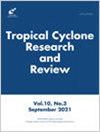Tropical cyclone activities in the western North Pacific in 2023
IF 4.1
4区 地球科学
Q3 METEOROLOGY & ATMOSPHERIC SCIENCES
引用次数: 0
Abstract
Using the best-track dataset from the Shanghai Typhoon Institute/China Meteorological Administration, the paper presents a detailed summary and analysis of tropical cyclone (TC) activities in the Western North Pacific (WNP) and the South China Sea (SCS) during 2023. Based on historical records from 1951 to 2020 as the climatology benchmark, we examine anomalies in TC frequency, origin locations, tracks, intensity, and duration, as well as landfall events across the Asia-Pacific region. TC frequency in 2023 is found to be lower than climatology, with a marked decrease during the autumn months. Origin locations of TCs, which mark the starting points of their paths, are generally consistent with climatology, although there is a noticeable northwestward shift in the origins of the intense TCs. Track density of named TCs is anomalously high within the 0–20°N and 110°E to 125°E longitude box, and offshore areas covering northwestern to southern Japan and around the Korean Peninsula. Comparisons of the means, medians, upper and lower quartiles all indicate that TC intensity is generally stronger than usual, with 8 out of 17 named TCs reaching super typhoon status. The duration of TCs maintaining tropical storm intensity or above also surpasses climatological norms. In terms of landfall, 6 TCs made landfall in China, totaling 11 events, while 11 TCs accounted for 20 landfall instances across the Asia-Pacific. The key anomalous annual TC activities are influenced by atmospheric and oceanic conditions modulated by a concurrent El Niño event, a positive North Pacific Mode, a negative Pacific Meridional Mode on the interannual scale, and the negative Pacific Decadal Oscillation phase and positive Atlantic Multidecadal Oscillation phase on the interdecadal scale.
2023年北太平洋西部热带气旋活动
本文利用中国气象局上海台风研究所的最佳轨迹数据,对2023年西北太平洋(WNP)和南海(SCS)的热带气旋(TC)活动进行了详细总结和分析。以1951 - 2020年的历史记录为气候基准,研究了亚太地区的TC频率、起源位置、路径、强度、持续时间以及登陆事件的异常情况。2023年的TC频率低于气候学,秋季明显减少。尽管强热带风暴的起源有明显的向西北移动,但它们的起源位置(标志着它们路径的起点)通常与气候学一致。在0-20°N和110°E至125°E经度范围内,以及覆盖日本西北部至南部和朝鲜半岛周围的近海地区,命名tc的路径密度异常高。比较平均值、中位数、上四分位数和下四分位数均显示,台风强度普遍强于平时,17个命名台风中有8个达到超级台风级别。热带气旋维持热带风暴或以上强度的持续时间也超过气候标准。在登陆方面,6个台风在中国登陆,共计11个,而11个台风在亚太地区登陆,共计20个。主要的年距平活动受El Niño事件调制的大气和海洋条件、北太平洋模态正、太平洋经向模态负、年代际尺度上太平洋年代际振荡负相和大西洋多年代际振荡正相的影响。
本文章由计算机程序翻译,如有差异,请以英文原文为准。
求助全文
约1分钟内获得全文
求助全文
来源期刊

Tropical Cyclone Research and Review
METEOROLOGY & ATMOSPHERIC SCIENCES-
CiteScore
4.60
自引率
3.40%
发文量
184
审稿时长
30 weeks
期刊介绍:
Tropical Cyclone Research and Review is an international journal focusing on tropical cyclone monitoring, forecasting, and research as well as associated hydrological effects and disaster risk reduction. This journal is edited and published by the ESCAP/WMO Typhoon Committee (TC) and the Shanghai Typhoon Institute of the China Meteorology Administration (STI/CMA). Contributions from all tropical cyclone basins are welcome.
Scope of the journal includes:
• Reviews of tropical cyclones exhibiting unusual characteristics or behavior or resulting in disastrous impacts on Typhoon Committee Members and other regional WMO bodies
• Advances in applied and basic tropical cyclone research or technology to improve tropical cyclone forecasts and warnings
• Basic theoretical studies of tropical cyclones
• Event reports, compelling images, and topic review reports of tropical cyclones
• Impacts, risk assessments, and risk management techniques related to tropical cyclones
 求助内容:
求助内容: 应助结果提醒方式:
应助结果提醒方式:


